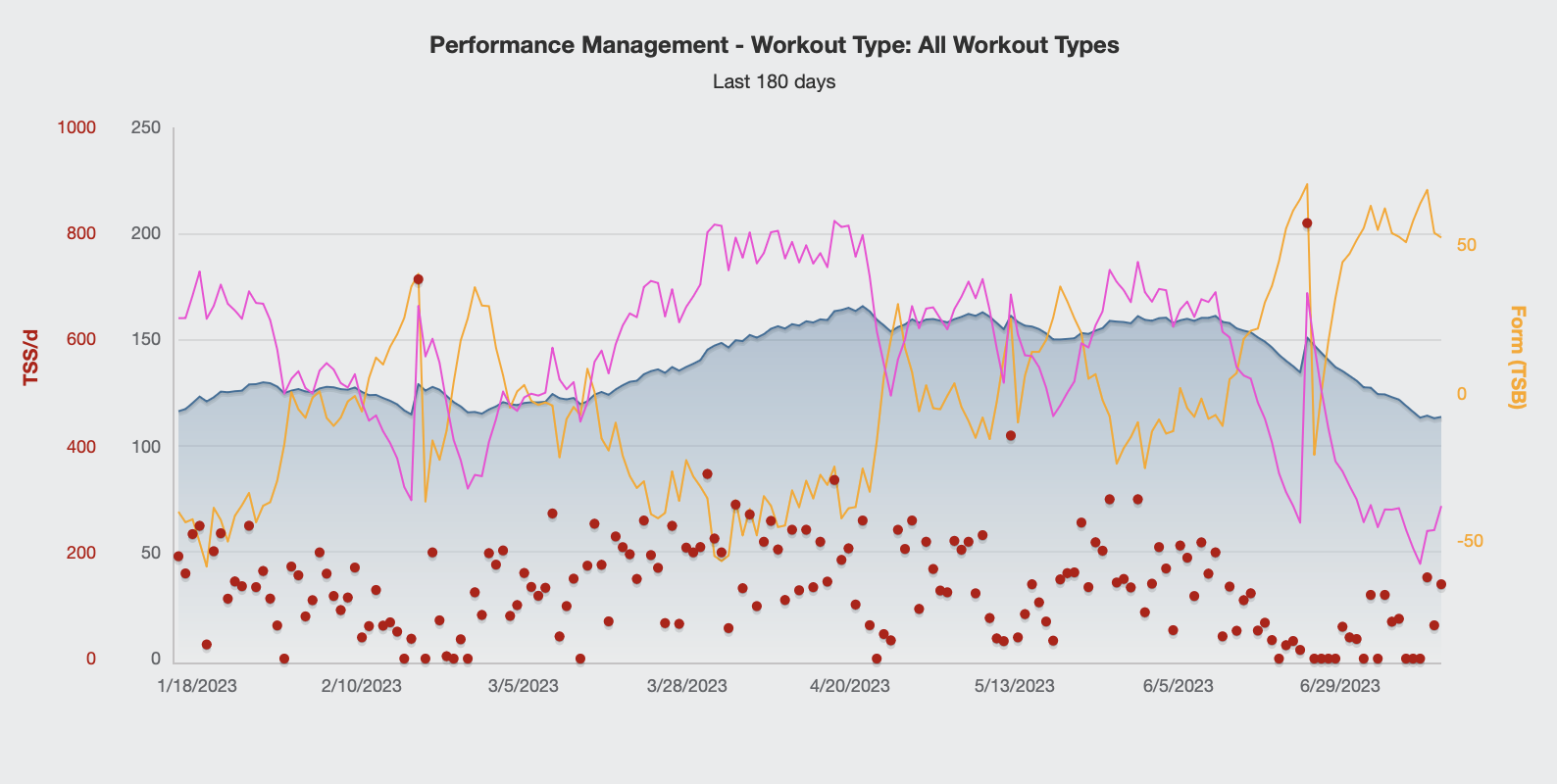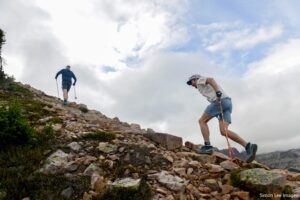The metrics that Training Peaks produces using the data uploaded from your GPS/HR monitor watch have potent implications for monitoring, controlling, and adjusting your training. I’ve often said that anyone can write a training plan….but the challenge is successfully applying it to the athlete so that it produces the best results. One of the biggest problems for coaches and athletes alike is assessing the training load on both a short and long-term basis and the effect that load has on the athlete. That’s been the driver behind the recent explosion in the use of the HRV (heart rate variability) features that have been appearing on every fitness app. The last article I wrote on this subject was at least six years ago and was due for an update. This latest version goes a bit deeper into the magic behind the metrics.
I will leave HRV for another discussion and focus on the Training Peaks metrics in the article. We frequently field questions concerning their meaning and interpretation. A brief history is in order to set the stage.
Training Peaks was initially set up to serve triathletes and cyclists. A clever exercise physiologist, Andrew Coggan, was looking for ways to quantify training load, fitness, and fatigue and developed the Training Peaks system. His models are a simplified version of an existing mathematical model developed by Eric Banister using the acronym TRIMP (TRaining IMPulse). The result was called the Performance Manager. For a VERY in-depth look at both these models, read this.
The exact details of these models and how they were arrived at are not important to the casual user. So, if you are willing to believe that Coggan’s models are accurate, we can move on to user-level discussion.
Definitions
Like any discussion, it is essential to start with a shared understanding of the terms and concepts we will discuss.
TSS– Training Stress Score is the foundational element of the whole system. Get this wrong, and the rest of the metrics won’t be correct. Like any algorithm, poor input data will yield poor output data. TSS quantifies the training load imposed by an individual training session. It is based on the duration and intensity of that session. Several methods of measuring TSS exist. This model uses the maximum sustainable intensity one can sustain for an extended time to establish a benchmark for the TSS. The ‘extended’ time will vary from 30 minutes for a moderately fit amateur to 60 minutes for an elite. That intensity can be measured by: power, pace, or heart rate. We call this by the old school name of the anaerobic threshold (AnT). Other names are Lactate Threshold (LT), Functional Threshold Power/Pace (FTP), and Critical Power/Pace. Establishing this intensity is vital to getting an accurate TSS.
- Power-based TSS (pTSS) is the most accurate because it uses the data output from a power meter (either cycling or, in some cases running*). It is very accurate because it measures the actual power and work the athlete is doing.
- Pace-based TSS (rTSS) is also quite accurate because the running pace is a nearly perfect proxy for power. Except when it is not……like: When it is windy, the terrain is hilly, or the ground is very rough. If that sounds like most of the time when you are in the mountains, you can see why rTSS is not helpful for mountain athletes.
- Heart Rate based TSS (hrTSS) also uses a proxy for mechanical work. Heart rate tracks pretty well to work or power output, but not perfectly. More on that later. But this makes hrTSS the least accurate of these three methods.
*Running power meters are discussed later.
CTL– Chronic Training Load measures how much training the athlete has been doing during the past six weeks. Based on TSS, it considers both the volume and intensity of that training. It uses an exponentially weighted running average TSS. That means the training you’ve done in the past few days affects the CTL number much more than the training you did six weeks ago. CTL is a reflection of only the positive effects that come from training. It makes intuitive sense that athletes who train more will be more fit. So, CTL is itself a proxy for your fitness. It is relevant only to yourself and not an absolute measure of fitness.
ATL-Acute Training Load is a backward-looking, exponentially weighted algorithm based on TSS for the last seven days. But this training has a more fatiguing effect than the training you did several weeks ago. So ATL is considering the negative (fatigue) effects of training. ATL is also a relative measure of fatigue, not an absolute value.
TSB– Training Stress Balance Is the difference between CTL and ATL (CTL minus ATL). Imagine that it is the sum of the positive training effects (increased fitness) and the adverse training effects (fatigue). This number should reflect the performance potential of the athlete. As anyone who has trained consistently before, fatigue will mask fitness such that you can’t express your full fitness potential when fatigued. TSB quantifies this again in a relative way.
The Performance Manager
The statements about the relative nature of these metrics were not made lightly. The more history the athlete has with these metrics, the more helpful they become. A weekly TSS of 1000 is high for any athlete, but the CTL, ATL, and TBS can vary depending on the athlete’s history. An elite athlete with a CTL of over 150 can handle a weekly TSS of 1200 during routine training and manage a fatigue/ATL of 200 without overreaching. An amateur with a CTL of 60 might struggle to handle a weekly TSS load of 500, resulting in an ATL of only 70.
Your actual performance on any day results from the constant give-and-take tug-of-war between CTL and ATL given by TSB. CTL indicates the performance potential, and ATL shows the potential performance reduction due to fatigue.
This is where the art of coaching comes in. Even using the Performance Manager, the trick is balancing the chronic and acute training load to arrive at the best performance on a given day. That can only be done with experience and a good data set.
The lesson here is the combination of the hard data from your GPS/HR watch combined with your notes on your subjective feelings about fatigue and fitness (that you should be keeping track of in the comments section) for each workout are a potent tool in your training toolbox.
The Performance Management Chart in the dashboard of all Training Peaks Premium account users is where these numbers find their graphical representation, as shown below. Here’s a short video walkthrough of the basics of the Performance Management Chart.
The Trouble(s) with Performance Manager Model
- In the definition of hrTSS above, I alluded to a problem when using heart rate as a proxy for work/power. Unfortunately, heart rate is not a great proxy for work output because many other factors impact it. When running or cycling in a steady state, the heart rate tracks well with pace or power. However, many real-world conditions routinely encountered by mountain athletes cause a decoupling of heart rate from work. The most common problem mountaineers face with hrTSS is that the heart rate usually does not reflect the effort or fatigue when hiking steeply uphill. Another failing of hrTSS is that heart rate drops on downhills at a rate that does not reflect the fatigue that comes from running downhill.
- The Performance Manager model recognizes only one benchmark to anchor your training intensity zones, hence TSS for each workout. While the AnT (or any of those other acronyms) is a marker of an important metabolic point where the lactate removal rate equals the lactate production rate*. But another critical metabolic point differs between athletes and must be considered to give individualized training recommendations. That point is the aerobic threshold (AeT). The Performance Manager model uses a formulaic approach that assumes this point to be about 80% of the AnT or FTP. The spread between these thresholds ranges from 7% for the very fittest to 30+% for the aerobically deficient.
*if this language is confusing, you would be well served to read chapter two of Training for the Uphill Athlete to better understand endurance physiology.
Our Solutions:
- An accurate TSS is critical for the Performance Manager model to give helpful feedback. Years ago, to help make hrTSS more reflective of the positive training effect (CTL) and the subsequent resultant fatigue that the athlete felt (ATL), I came up with fudge factor(s) for workouts with a very high muscular endurance load like very hilly runs or hikes with and without weight. These are admittedly not scientifically derived. They come from hundreds of interactions with athletes. They attempt to acknowledge the added training effect of CTL and fatigue, ATL, that results from having to work against gravity.
Fudge Factors
- Add 10TSS to a workout for every 300 meters or 1000 feet of elevation gain and loss.
- In addition, add 10TSS for every 10% of body weight carried for every 300 meters or 1000 feet
- To solve this problem of having only one physiological marker to define training intensity zones, we strongly recommend athletes do an aerobic assessment and then set their intensity zones based on these two important metabolic events.
Muscular endurance (ME):
A hard muscular workout, such as a grueling ME workout, typically has a very high local muscular endurance factor at a (disappointingly) low heart rate. To determine TSS, pick a number that reflects the recovery time before you feel ready for another such workout. For slow twitch muscle fiber–dominant athletes, these ME workouts take a significant toll and require 72 hours of recovery, during which only easy aerobic work is done. If that is you, score your ME workouts at 150–200 TSS. Fast twitch–dominant athletes with a lot of strength training or sprinting in their backgrounds can handle these ME workouts more easily and can bounce back in 48 hours. If you fall into this camp, give your ME workouts 100 TSS.
Training for the New Alpinism general strength and core workout:
Give this a TSS of 50–70/hour.
TftNA max strength with a core warm-up:
Give this a TSS of 80–90/hour.
Climbing workouts:
We consider climbing sessions to be strength training. As mentioned above, the Training Peaks metrics do not accurately reflect strength training sessions, especially when using hrTSS, because heart rate is a poor proxy for effort.
- General strength: 50 TSS/hour
- Max strength: 75–80 TSS/hour
- ARC training (below onsight level): 50 TSS/hour; count only time on the rock.
- ARC training (at or near max level): 80–100 TSS/hour; count only time on the rock.
Perhaps these fudge factors seem arbitrary and too formulaic to apply across broad swaths of athletes. Still, they reflect an attempt to portray workload and recovery times based on our observations with hundreds of athletes.
Running Power Meters and How They Might Change Things
I want to start with a disclaimer: I am not very knowledgeable about power meters. I bought and tried one of the earliest Stryd power meters several years ago. It didn’t reflect my perceived exertion on either uphills or downhills. It was a shot in the dark, as I think they were intended for road runners.
The offerings in the running power meter market are much increased and improved. Most watch companies offer this feature and several claim that theirs will work well for trail running by including the athlete’s elevation change in their algorithm.
The way these things work is that using accelerometers, they measure things like vertical oscillation, ground contact time, elevation change, and probably a few other things. They do this by collecting data from your HR chest strap, a foot pod, or the watch itself. They feed this data into their proprietary algorithm and out pops a running power number in watts.
I have no experience with any of the major brands’ power meters. In my quest to learn more about power numbers for monitoring training, I stumbled across an interesting website by physicist/mountain runner Markus Holler. Markus has developed his algorithm (for Garmin only) that will crunch the same input data. On his site, Markus details what goes into his model vs. what he thinks might be missing from the big brands’ models. I was so impressed with Markus’s clear explanation and transparency that I immediately bought his e-book (available on his site) to learn more about running power, how it is modeled, and how to train and race using it. I recently did a podcast with Markus where he leads us through the basics of measuring power in trail running and then explains how the data can be fed into the Training Peaks Performance Manager. The result will be a much more accurate TSS for trail runners.
One of its most unique features is that in the setting of the app you can include the weight of a pack you might be carrying. This will be important to ultra runners who might be carrying 2-3kg on very long runs. Markus does not think it will work so well for mountaineers carrying a heavy pack. In that case, the muscular load is much higher, and the training effect is a bit different. Mountaineers might still have to rely on the fudge factors described above.
*I had originally stated here that I didn’t think that the RunPowerModel could account for carried weight. Markus brought this to my attention.
I’m very intrigued by what I have learned from Markus and feel that this is a significant step in making the science part of training for trail/mountain more exact. There will remain the art component.
NOTE:
In the early days of Uphill Athlete and my earliest and incomplete understanding of the Performance Manager, I suggested that mountain athletes could achieve CTL fitness scores to ensure their fitness was sufficient for a particular objective. My heart was in the right place in wanting to simplify training down to one number for folks to target. Even then, I recognized that this would not work as well for mountain objectives as it was working in the triathlon world, where a CTL of 150 was considered the price of admission to a sub-9-hour Ironman triathlon.
In my more limited experience working with the Performance Manager (this was eight years ago), I saw a trend that I thought would be helpful. I posted specific numbers on the Uphill Athlete site about different CTLs needed to assure the climber that their fitness was adequate for the task.
Boy, did I open a can of worms. I’m flattered to think people took my words to heart, but I’m as fallible as the next person. I had intended those numbers to be rough guidelines encouraging people to be well prepared for their climb, not as hard and fast rules. Before the concepts I had developed and written in both books were widely accepted, there wasn’t a culture of training for big climbs. Many people were undertaking mountain climbs for which they were unprepared, often with severe consequences.
Two things have happened in those intervening years. There is now a more robust culture of mountaineering training. And our coaches and I have often had to explain away the climber’s apprehension that not having a CTL of 100 would mean they were unprepared for Denali.
The preceding discussion should clarify that holding a CTL above 100 for a month will make an athlete fitter than that athlete holding a CTL above 80 for two weeks after a week of over-reaching.
I should have known better……but…… I will no longer try to predict fitness for people whose training I am unfamiliar with.




 Facebook
Facebook

Scott, another great article. This piece by David Warden is also highly informative and echoes most of what you said: https://www.8020endurance.com/performance-management-chart-is-lying-to-you/.
At the end of the day, our CTL numbers are completely individual and cannot be used to compare ourselves to other athletes, because CTL is driven by TSS which is driven by AnT. I could have a CTL of 130 (which I don’t – yet) the same as an elite athlete like e.g. David Goettler, and yet his AnT pace would be signficantly faster than mine because he is vastly fitter. CTL can only be used to compare ourselves to ourselves, assuming we are re-testing AeT and AnT regularly so that our zones are up to date and therefore our TSS is being measured consistently.
Since the bulk of training for most mountain sports should be done at or below AeT, the only way to increase CTL in a sport-specific way is to steadily increase Z1-Z2 volume over time. At some point, us amateurs will hit an upper limit to the volume we can add, as life, work, and family will get in the way, and so even with a steady increase in fitness and regular AeT and AnT testing to ensure our zones are properly set, realistically the vast majority of amateur athletes can never hit the same numbers as the elites. Unfortunately the biggest goals also require the biggest sacrifices, and so no matter how badly we want to climb Everest or K2, we may simply not have the time to dedicate to training at the volume required without making unacceptable sacrifices to other areas of our lives or creating unacceptable risk in taking on such an expedition while underprepared.
Realistic goal-setting is an uncomfortable topic for some, as it means scaling back their ambitions, but just as important as setting zones and consistently executing a training plan. In fact, I think that would be a great topci for an article or podcast, since the majority of your audience are amateurs who need to do exactly this. As you mention, the consequences of taking on an objective you are not prepared for are often severe.
Absolutely agree!
Thanks Scott for the info.
I took your advice about running from previous comments, where I mentioned my difficulty with running and pain in my ankles and feet despite only being 33. I have been playing frisbee with friends more, doing some stair climbs, and short little jogs with lots of walking in there, and been doing yoga again to get some mobility back. I realized that all the time I’ve spent on my bicycle this last year has really hampered my mobility and fitness outside of that modality.
But! I managed a 3 mile run the other day, granted it took me almost 30 minutes to do, and 10 years ago I ran an 18 min 5k, but, ya know, I did the whole crossfit thing from that year for the next 5 and slowly got rid of my endurance lmao. So back on the long road to recover it.
Thanks for giving me tools and knowledge to arm myself with.
Hey Scott, I’ve been loving the monthly book club.
Quick clarification here. For the TSS Fudge factors for elevation, you wrote
>”Add 10TSS to a workout for every 300 meters (or 1000 feet of elevation gain and loss.)”
Does that mean, if I gained 300m and then descended 300m, I would add 20tss?
Would that also apply to the weight-carrying TSS fudge factor (10ss for 10% additional body weight)? Add it for both ascended and descended 300m?
Thanks for your insight
Hello Levi,
Great question-the most important thing about TSS fudge factors in general is for you to keep it consistent for your training. As a coach and athlete myself I would add 10TSS for 300m (1,000ft) gain and loss. Given the athlete was outside on the same or close to similar terrain. If an athlete is on a treadmill or stairmaster I will likely give them less since they aren’t loading their legs on the way down as well. However, if you want to keep it simple and always add 10TSS/300m or if you are always training inside that is okay as long as you keep it consistent. Same idea for the 10TSS/10% of body weight per 300m. I would do this for a day where you are outside gaining and losing the same elevation. So if I have an athlete who has done a 600m day with 10% body weight outside I would give them an extra 40TSS on top of their hrTSS.
Each coach and athlete does it a little differently. I know some coaches just add an extra 10TSS/10% of body weight just on top of the total TSS and not for every 300m gained. My best advice is to keep your data as consistent as possible! I hope that helps!
Curious what a good fudge factor would be for steep hill sprint workouts?
If you are really giving ‘er in these I think 100TSS is a reasonable score ion you can manage more that 5-6 reps.